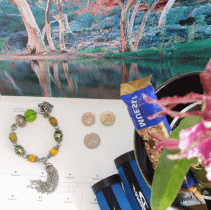|
|
|
My first Haldi KumKum
Mid of last week I got an email with an invitation to 'Haldi KumKum'. My friend is Indian - so that gave me at least a rough direction. I was available and since I am open minded and interested - something that some people call 'nosey' - I was only too happy to accept.
I silently thanked the inventor of the internet, and off I went to consult my computer... only to find all sorts of stuff to buy for this event, but only one article to explain it.
Well I usually don't copy whole articles, but this site may not exist forever, better not lose the info - who knows if I would be able to describe correctly what I were about to experience.
|
January Fairs Festivals : Haldi Kumkum
HALDI KUMKUM: Women's Fun Meetings
A celebration which satisfies the feminine need to dress up is Haldi Kurnkum. This is a get-together organised by women for women and is held on several festive days of the year. There is no religious or historical significance attached to this celebration. It has gained popularity because such gatherings present opportunities for women to invite friends, relatives and new acquaintances to meet in an atmosphere of merriment and fun. On such occasions, the hostess distributes bangles, sweets, vermillion, small novelties, flowers, betel leaves and nuts as well as coconuts.
Sankrantils the first festival during which Haldi Kurnkum meets are organised. Women decorate their homes with floral torans and distribute sesame sweets and gifts to their friends. Haldi Kurnkums are also held during the first month of spring, Chaitra. On these occasions, women joyfully share the fruits and vegetables of the season and have a feast of mangoes, jackfruit, melons and sprouted pulses cooked with spices. Later in the year, Haldi Kurnkum festivities are also held during Mangalagauri, Haritalika andNavaratri. Haldi Kurnkum gatherings are occasions when newly married women show special respect to their elders by seeking their blessings. Young brides take great pleasure in dressing up in traditonal garments and jewellery.
The custom of holding Haldi Kumkums was common during the rule of the Marathas and Peshwas in Maharashtra. Palaces of the time had specific areas created for these very celebrations with stone troughs built for holding the vermillion and turmeric powders. In those days, queens or courtiers' wives, gave opulent gifts to their guests. Similarly, gifts of jewels and rich clothing were offered to goddess Bhavani or Parvati before the Haldi Kurnkum season began. In days gone by and even now in orthodox Hindu families, such occasions were meant only for single or married women and excluded widows who were considered inauspicious and thus unwelcome. The lowly status of widows is a major shortcoming of Hinduism. But in urban, educated homes, such gatherings are becoming more open and are called Sakhi Sammelans or women's friendly gatherings. Chaat and different kinds of spicy snacks, sweets or special foods associated with the season are shared. Nevertheless, the purpose of most feminine festivals is to pray for the welfare and prosperity of the family.
January brides who get married around Sankranti celebrate Haldi kurnkums with fanfare. Henna patterns on the hands, green and gold bangles worn with an ornate green and gold sari, adorn a bride for this special occasion.
[Bottom] Women who express devotion to their famifies, venerate theV'dl specially and have symbolic ties oflove and affection with this gigantic tree which grows in every region and lives for centuries
from: All India Travel
|
|
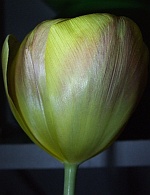 |
|
Thus enlightened I went to my friends house, and surely they stayed with the tradition. She and her mother-in-law were dressed in the most beautiful green Saris with gold decorations and the most beautiful gold and green jewellery. Juice and crisps were served and her little boy, just 8 month now, kept us company until all of the guests had arrived and we had a wonderful sweetened cinamon tea.
It then turned out that the event was a double occasion with a kind of baby shower at the same time, since for him it was the first return of Sankranthi an occasion deserving a ceremony for his blessing.
|
The ceremony started with us sitting in a circle on the floor and the ladies singing in which I obviously couldn't participate. One was creating the rhythm with some sort of brass jingles, which was very nice. For us Westerners everything 'Indian music' is somewhat associated with Bollywood, but this was very different. Sitting there and listening to these flowing rhythms had something very calming and beautiful.
| Then the singing changed into something that I guess were sung prayers standing in front of a beautifully decorated shrine for lord Krishna and the goddess Lakshmi.
All of a sudden things got busy and I found myself on a sofa with a plate of food. And yummy that was! Very simple and plain, but so tasty.
|
|
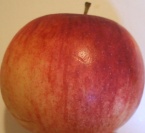 |
Foods in colours of Haldi KumKum: naturally yellow semolina cooked with spices and orange sweet carrots cooked in milk. Indians sure know how to prepare food.
So yes, during all the things that went on I was filled in a bit. I learned that Haldi is turmeric a beautiful yellow spice and KumKum is a red dye called vermillion. It is the powder Indian women use for the red dot on the forehead. Another Indian friend had told me about the meaning of the dot, but to make sure I get this right I rather quote 'About.com, Bindi - The Great Indian Forehead Art:
|
A Hot Spot!
The area between the eyebrows, the sixth chakra known as the 'agna' meaning 'command', is the seat of concealed wisdom. It is the centre point wherein all experience is gathered in total concentration. According to the tantric cult, when during meditation the latent energy ('kundalini') rises from the base of the spine towards the head, this 'agna' is the probable outlet for this potent energy. The red 'kumkum' between the eyebrows is said to retain energy in the human body and control the various levels of concentration. It is also the central point of the base of the creation itself — symbolizing auspiciousness and good fortune.
How to Apply
Traditional bindi is red or maroon in color. A pinch of vermilion powder applied skillfully with practiced fingertip make the perfect red dot. Women who are not nimble-fingered take great pains to get the perfect round. They use small circular discs or hollow pie coin as aid. First they apply a sticky wax paste on the empty space in the disc. This is then covered with kumkum or vermilion and then the disc is removed to get a perfect round bindi. Sandal, 'aguru', 'kasturi', 'kumkum' (made of red turmeric) and 'sindoor' (made of zinc oxide and dye) make this special red dot. Saffron ground together with 'kusumba' flower can also create the magic! |
|
 |
|
So now the door opened and grandma entered with the little boy on her arm. Gosh he was cute - all dressed up as lord Krishna, with crown, flowers and a big fluffy nappy. He was placed on a green, round, little blanket and then a tray with a candle, a little box containing the spices and something that looked more grainy like broken rice, a golden ring and sesame biscuit was swayed around and above him. The vermillion was used for a dot on the forehead the grains were sprinkled over his head, the ring touched his temples and was swayed over the head and then he was fed a tiny bit of biscuit - what for some reason seem to confuse him most. |
| Well, my turn was last as I needed quite a bit of observing to get it remotely right, and by then the little chap had got used to the biscuits and happily nibbled it off my fingers.
Only when he was showered with sweets like 'Celebrations' and biscuits, he decided that enough is enough and started crying.
The traditional shower is to be executed with some sort of fruit the size of cherries, but I was told that they usually don't go down better - in contrary. Here in England parents have the excuse of not being able to get hold of the fruits, but even in India they now turn more and more to the sweets, much to the pleasure of the older kids.
|
|
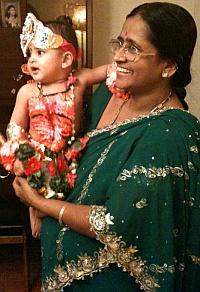 |
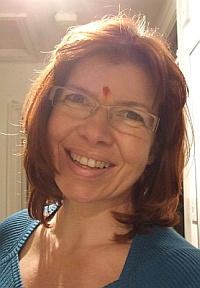 |
|
The sesame is considered a warm seed which in a cold season like we have now is supposed to give you warmth and a good feeling. After more of the lovely cinnamon tea the two hostesses, came round to each of their guests and gave them a similar blessing with the vermillion and the sesame biscuit, just that we got a whole one - yay! I love sesame and they were wonderful. And that is how I came to have my first red dot.
After we were presented with a tulip and an apple which both were carrying the colours of Haldi KumKum the party ended.
Thank you Sarika for a wonderful experience. I feel blessed that you invited me to be a part of it!
|
All the best to your and your family's future,
Love
Rika
xx
January 2010
|
|
Articles on Lifestyle
Culture
Haldi KumKum
Live & Let Live
Why: "How 2 Kitchen"
Money
Money, Money, ...
Motivation & Fun
Who's listening?
Eureka Moments
Inspiration vs. Motivation
The real Teese
Tummy & Co
Obsessions
Nine Words
Cycle of Life - Some Thoughts
Internet and Branding
Brilliant Business Women
The Typecast Trap
Garden without Fuss
Mills & Boon
About Veg
Pushing the Limits
About Criticism
Forum on RFOS
Achievements
Bringing it together
Reflection...
...Bringing it together-Part 2
Time Management
Passion
Creativity
Relationships: Cliché!?
Incredible List of Rules
Movies
The Invention of Lying
Networking
Nerds VS. Dilettantes
Knitting 21st Century Style
A Network Is A Home
Serious Game
Networking Strategy
Restaurants
Milsoms - Kesgrave Hall
Court Restaurant London
Techie Stuff
IL and the Internet
Travel
Ideas
To Sumatra as Eco Tourist
Bad Nenndorf
Two Gals no Men: Wellbeing
London
A Posh Day Out!
A Market Day Out!
Fuerteventura 2009
Travel Diary
Travel Read
Fuerteventura 2008
Fuerte - The Island
Fuerte - Dirary & Club Life
Fuerte - Shopping
Fuerte - Jet Ski
Fuerte - What else?
Tuebingen 2008
A Day out in Town
The Gallery
Misc
Natural History Museum
What I Pack
Lowestoft Airfestival
|
|


